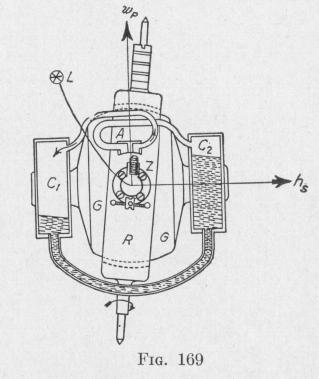216 NAVIGATIONAL COMPASSES
about one-eighth inch some 180 times per minute. The compass card is attached to the vertical ring and the lubber ring is attached to the outer frame.
The unspinning gyro-wheel and casing constitute a non-pen
dulous system with respect to the horizontal trunnions connecting
it to the vertical ring. The vertical ring and supporting frame
constitute a pendulous system capable of oscillating about a hori
zontal axis. The required meridian-seeking torque is produced
by displacements of oil between two connected " control " or " working bottles " C , C2, Fig. 169, fastened to the gyro-casing G. The displacement of oil is due to an air-blast issuing from an upward directed nozzle Z fixed in the vertical supporting ring R. The rotation of the gyro-wheel produces a strong blower effect. The trunnions carrying the gyrocasing are tubular, and one of them conducts air to the nozzle Z. When the ring is vertical and the spin-axle is horizontal, this
air-blast enters the two sides of
the "air-box" A equally and produces equal pressures on the sur
faces of the oil in the two control bottles. When the gyro-axle
is tilted as in Fig. 169, oil is forced from the lower to the higher
control bottle, thereby developing a torque on the gyro-system
about an axis perpendicular to the plane of the diagram and in the
direction represented by the symbol at L. If the direction of
spin is in the direction represented by the arrow h,, then the gyro
axle will precess about a vertical axis in the direction represented
by the arrow wp.
Now consider the effect of the rotation of the earth on the direction of the spin-axle of a Brown gyro-compass. Imagine that we are above the northern hemisphere of the earth looking at a Brown gyro-compass at X (Fig. 170). Suppose that the spinaxle is horizontal, not in the meridian plane, and that the direction of spin is that represented by the arrow marked h3. The pendulous frame and ring are vertical. Because of the rotation of the earth, the instrument will move into the position Y. The pendulous
THE BROWN GYRO-COMPASS 217
frame and ring continue to be vertical and the direction of the spin-axle continues in the same direction in space that it was when the instrument was at X. The resulting displacement of the gyrocasing with respect to the vertical frame causes an excess of air to enter the western control bottle and consequently an excess of oil to enter the eastern bottle. A torque is thereby produced about
an axis perpendicular to the spin-axis and in the direction represented by the symbol at L, Fig. 170. As the spin-axle moves toward parallelism with this torque-axis, it moves toward the meridian plane with the direction of spin in the direction of the rotation of the earth. The displacement of oil from one control bottle to the other causes this non-pendulous sensitive element to act as a pendulously mounted gyro. For this reason it is common to speak of the " degree of pendulousness " of the Brown sensitive

